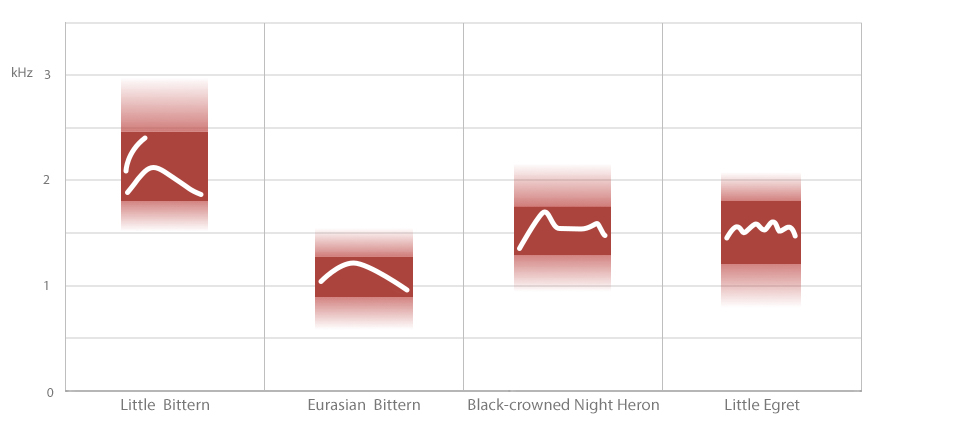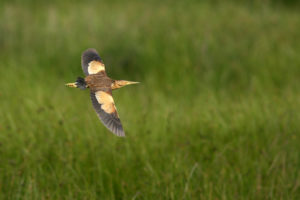The NFC can be described as having an intermediate position among those described for the other species. There is a real confusion risk with Black-crowned Night Heron as they share mean pitch (mean frequency 1.5 kHz, n=103), yet Little Egret sounds different most of the time. The timbre is much the same as in calls of Little Egret flushed by day. As in those much longer and more stressed calls, the NFC sounds essentially gurgling and guttural and can be transcribed as argh (like the human exclamation but shorter) or airgh, so it rhymes with “air”. It is as if the bird has a mouth full of water and is yelping for “air”.
Little Egret Egretta garzetta, Sagres, Vila do Bispo, Portugal, 22:58, 15 October 2015 (Magnus Robb). Flight calls of a flock of nocturnal migrants flying over a fortress and out over the Atlantic.
The intermediate character becomes obvious when looking at the shape of the call. Although it appears to vary, most of the time it looks like a diffuse arch, or an arch within a cloud. As the description argh suggests it goes down slightly at the end and sometimes even rhymes with “aʊ”. But confusion with Eurasian Bittern is unlikely owing to its high pitch. On other occasions you will see dense frequency bands (to an extent that I have not seen in Black-crowned Night Heron yet) as in short-distance contact calls of Little Bittern, but once again frequency excludes the latter quickly. If the downward inflected “aʊ” is not apparent, confusion with Black-crowned Night Heron becomes more likely. In this case listen for the gurgling timbre and additional croakiness, which seems to be more common in this species. Looking at several calls I see a varying but distinct zigzag line instead of a smooth arch; something I have not seen in other heron’s NFCs. It may prove to be diagnostic when present.
Little Egret Egretta garzetta. Five variations of argh call, from a minimum of three different individuals on the same night. 1) 23:22, 2) and 3) 22:20, 4) and 5) 22:58. Sagres, Vila do Bispo, Portugal, 15 October 2015 (Magnus Robb).

 Fig. 1 Little Bittern Ixobrychus minutus, Eurasian Bittern Botaurus stellaris, Black-crowned Night Heron Nycticorax nycticorax and Little Egret Egretta garzetta: mean position of NFCs (deep red) along frequency axis. The central deep red begins to fade at mean of highest frequency and mean of lowest frequency measured within a call. The outer ends of the fading colours represent the maximum of the highest or minimum of the lowest measured frequency within a call, respectively.
Fig. 1 Little Bittern Ixobrychus minutus, Eurasian Bittern Botaurus stellaris, Black-crowned Night Heron Nycticorax nycticorax and Little Egret Egretta garzetta: mean position of NFCs (deep red) along frequency axis. The central deep red begins to fade at mean of highest frequency and mean of lowest frequency measured within a call. The outer ends of the fading colours represent the maximum of the highest or minimum of the lowest measured frequency within a call, respectively.

